
Jerome, also known as Jerome of Stridon, was a Christian priest, confessor, theologian, and historian; he is commonly known as Saint Jerome.

Queen of Heaven is a title given to the Virgin Mary, by Christians mainly of the Catholic Church and, to a lesser extent, in Anglicanism, Lutheranism, and Eastern Orthodoxy.
The Venerable is a style, title, or epithet which is used in some Western Christian churches, and to translate similar terms used with clerics in Eastern Orthodoxy and monastics in Buddhism.

Dorotheus of Gaza or Abba Dorotheus, was a Christian monk and abbot. He joined the monastery Abba Serid near Gaza through the influence of elders Barsanuphius and John. Around 540 he founded his own monastery nearby and became abbot there. It was to the monks of this monastery that he addressed his instructions/teaching of which a considerable number have survived and have been compiled into Directions on Spiritual Training, originally composed in Greek and translated in medieval Syriac, Arabic, Georgian, and Church Slavonic. It is typical that at the heading of his teachings he announces that he offers his teaching "following the death of Abba John the Prophet and the complete silence of Abba Barsanuphius". It seems that as long his holy spiritual fathers lived he thought that he should live in obedience, keep silent and not give his own teaching. Only after the demise of one and the decision of the other not to speak did he decide to record his ascetic experiences, in order to edify the monks at the new monastery. He presents his teaching looking to one sole aim, the edification of those to whom it is addressed. He is not interested in elegance of expression or style. Thus, his words are uncontrived, clear and simple. A careful study of the teachings of Abba Dorotheus shows a strict logical structure in an intelligible and analytic manner. The matters are not approached in a theoretical way, but on the basis of everyday reality and on his monastic experience. He primarily links his teaching with the Holy Scripture and often introduces the subjects by starting from a biblical quote or passage, mainly from the Old Testament. Furthermore, he uses biblical citations from both the Old and New Testament throughout the development of his thought. In his practical teaching, Abba Dorotheus does not ignore the theology of the Church. In his thought, theology and the practical-ascetic life coexist. He certainly is not interested in giving some doctrinal teaching. Nevertheless, his practical teaching is saturated by the faith of the Church. Abba Dorotheus is recognized as a saint by the Eastern Orthodox Church and Roman Catholic Church and Oriental Orthodox Church with his Feast Day on June 5 in the Roman Catholic Church, June 18 in Churches of Eastern Orthodox tradition and August 13 in the Eastern Orthodox Church.

The Rule of Saint Augustine, written about the year 400, is a brief document divided into eight chapters and serves as an outline for religious life lived in community. It is the oldest monastic rule in the Western Church.

Marcella (325–410) is a saint in the Roman Catholic Church and Orthodox Church. She was a Christian ascetic in the Byzantine Era. According to Butler, "Having lost her husband in the seventh month of her marriage, she rejected the suit of Cerealis the consul, uncle of Gallus Cæsar, and resolved to imitate the lives of the ascetics of the East. She abstained from wine and flesh, employed all her time in pious reading, prayer, and visiting the churches of the apostles and martyrs, and never spoke with any man alone."
Saint Melania the Elder, Latin Sancta Melania Maior was a Desert Mother who was an influential figure in the Christian ascetic movement that sprang up in the generation after the Emperor Constantine made Christianity a legal religion of the Roman Empire. She was a contemporary of, and well known to, Abba Macarius and other Desert Fathers in Egypt, Saint Jerome, Saint Augustine of Hippo, Saint Paulinus of Nola, and Evagrius of Pontus, and she founded two religious communities on the Mount of Olives in Jerusalem. She stands out for the convent she founded for herself and the monastery she established in honour of Rufinus of Aquileia, which belong to the earliest Christian communities, and because she promoted the asceticism which she, as a follower of Origen, considered indispensable for salvation.

Our Lady of Mount Carmel, or Virgin of Carmel, is the title given to the Blessed Virgin Mary in her role as patroness of the Carmelite Order, particularly within the Catholic Church. The first Carmelites were Christian hermits living on Mount Carmel in the Holy Land during the late 12th and early to mid-13th century. They built in the midst of their hermitages a chapel which they dedicated to the Blessed Virgin, whom they conceived of in chivalric terms as the "Lady of the place." Our Lady of Mount Carmel was adopted in the 19th century as the patron saint of Chile.

Saint Melania the Younger is a Christian saint and Desert Mother who lived during the reign of Emperor Honorius, son of Theodosius I. She is the paternal granddaughter of Melania the Elder.
Heroic virtue is a phrase coined by Augustine of Hippo to describe the virtue of early Christian martyrs and used by the Catholic Church. The Greek pagan term hero described a person with possibly superhuman abilities and great goodness, and "it connotes a degree of bravery, fame, and distinction which places a man high above his fellows". The term was later applied to other highly virtuous persons who do extraordinary good works.

Fabiola was a nurse (physician) and Roman matron of rank of the company of noble Roman women who, under the influence of the Church father Jerome, gave up all earthly pleasures and devoted themselves to the practice of Christian asceticism and charitable work.
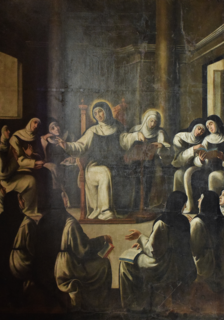
Paula of Rome (AD 347–404) was an ancient Roman saint and early Desert Mother. A member of one of the richest senatorial families which claimed descent from Agamemnon, Paula was the daughter of Blesilla and Rogatus, from the great clan of the Furii Camilli. At the age of 16, Paula was married to the nobleman Toxotius, with whom she had four daughters, Blaesilla, Paulina, Eustochium, and Rufina. She also had a boy, also named Toxotius.

Eustochium. Born Eustochium Julia at Rome, she was the daughter of Paula and is also venerated as a saint and was an early Desert Mother. She was the third of four daughters of the Roman Senator Toxotius, for whom Jerome made a number of disputable claims of ancestry. After the death of her husband around 380 Paula and her daughter Eustochium lived in Rome as austere a life as the fathers of the desert. Eustochium had three sisters, Blaesilla, Paulina, and Rufina, and a brother, Toxotius.

Osanna of Cattaro was a Catholic visionary and anchoress from Cattaro. She was a teenage convert from Orthodoxy of Serbian descent from Montenegro. She became a Dominican tertiary and was posthumously venerated as a saint in Kotor. She was later beatified in 1934.
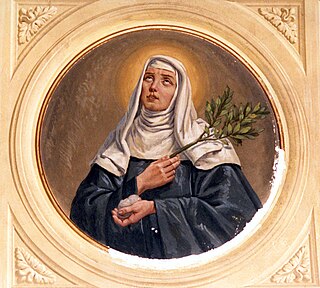
Veronica of Milan was an Italian nun in the Augustinian Order. She was reputed to have received frequent visions of the Virgin Mary, and her local cultus was confirmed by Pope Leo X in 1517.
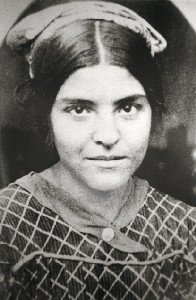
Maria Sagheddu - in religious Maria Gabriella - was an Italian Roman Catholic professed religious and a professed member from the Trappists. Sagheddu had an intense spiritual devotion to ecumenism - something for which she had offered her life - since she desired that all would become one in Jesus Christ. Her childhood saw her noted as stubborn and obstinate though her increased activeness in teaching catechism and joining Azione Cattolica saw those qualities melt and become gentleness and careful attentiveness.
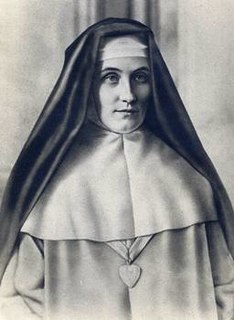
Mary of the Divine Heart, born Maria Droste zu Vischering, was a German noblewoman and Roman Catholic nun of the Congregation of Our Lady of Charity of the Good Shepherd, best known for having influenced Pope Leo XIII to make the consecration of the world to the Sacred Heart of Jesus. Pope Leo XIII himself called the solemn consecration "the greatest act of my pontificate".

Women in Church history have played a variety of roles in the life of Christianity - notably as contemplatives, health care givers, educationalists and missionaries. Until recent times, women were generally excluded from episcopal and clerical positions within the certain Christian churches; however, great numbers of women have been influential in the life of the church, from contemporaries of Jesus to subsequent saints, theologians, doctors of the church, missionaries, abbesses, nuns, mystics, founders of religious institutes, military leaders, monarchs and martyrs.

The Feast of the Conception of the Virgin Mary is a liturgical holiday celebrated on December 9 by the Orthodox Church and a number of Eastern Catholic Churches. It is also the name given in the Catholic Tridentine Calendar for 8 December. In the present General Roman Calendar, the feast is called the Solemnity of the Immaculate Conception of the Blessed Virgin Mary. In the Eastern Orthodox Church, the holy day was once called the Feast of Conception of Saint Anne.
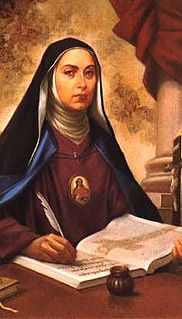
Giulia Crostarosa was an Italian Roman Catholic nun who founded the Order of the Most Holy Redeemer (Redemptoristines). She reported a series of visions that led to the establishment of a congregation with its own rule. She assumed the religious name of "Maria Celeste" when she became a professed nun.
















